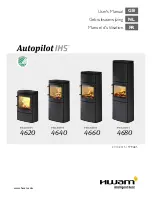
D I R E C T I O N S F O R U S E A N D S TO K I N G
10
Please refer to the specific installation instructions con-
cerning the recommended quantities of wood and the
position of the regulation handles on your stove.
First, some information about the different regulation pos-
sibilities of your stove.
Primary air
The primary air is used when lighting the stove and in order
to get the stove going when refuelling. The primary air should
always be closed when the stove is functioning continuously.
The handle is often placed on the ashtray, but it can also be
located on the stove itself.
Choke
Some models are equipped with an ashtray with a separate
choke. As long as the choke is kept open, you supply the
stove with supplementary air. When you let go of the choke,
the air is automatically closed.
Combustion air
The combustion air is preheated in canals around the com-
bustion chamber, from where it is led in front of the glass
and then into the fire. Apart from providing oxygen to the
combustion, the combustion air contributes to keeping the
glass clean. If you close the combustion air too much, the
risk of getting sooty glass is increased. You can regulate the
desired heat quantity with the combustion air.
CB-technique (Clean-Burn)
Stoves equipped with a Clean-Burn technique have a sepa-
rate canal that leads extra combustion air (tertiary air) into
the combustion chamber. This air is introduced in the com-
bustion chamber through the small holes in the stainless-
steel rail right beneath the ceramic smoke deflector.
Ceramic smoke deflectors
There can be one or more ceramic smoke deflectors that are
placed in the upper part of the combustion chamber. Their
function is to lower the temperature of the smoke before it
goes up into the chimney, so the stove gives off more heat.
After the chimney has been swept, you should remove or
rock the ceramic smoke deflector(s) in order to remove the
resulting soot (see the specific instructions delivered with
your model). We recommend that you treat the ceramic
smoke deflector with caution. They are made of a porous
material (Skamol) and are not included in the warranty (they
are, however, extremely heat-resistant!).
The first lighting
For lighting use pieces of crumbled paper (newspaper) and/
or fire lighters, which are placed on the grate in the bottom
of the combustion chamber.
Never use alcohol or other
flammable liquids!
Put 2-3 small bags of fire lighters in the bottom of the com-
bustion chamber. Then place about two kgs wood (small
pieces) on top of the fire lighters. Open the primary and the
secondary air 100%. Light the fire lighters and leave the
door ajar the first 10-15 minutes. By doing this, the glass
is preheated and you avoid soot building on the glass. You
can also open the shaking grate or the ashtray 1-2 cm if you
need supplementary air. However, the primary air and the
shaking grate must always be closed when firing continu-
ously. When the layer of embers is well developed, the stove
is ready for the first portion of wood.
Please note that the paint will harden the first time the stove
is used. This will result in a burned smell, which disappears
when the room is thoroughly aired.
Continuous firing
It is important to obtain a high temperature as fast as pos-
sible in the combustion chamber. Thereby the stove and
the fuel are exploited in the best possible way, and you will
get a clean combustion. You will also avoid a sooting of the
firebricks and the glass. When the stove is in use, the smoke
should only be faintly visible as a movement in the air.
After about 10-15 minutes, when you have a well-devel-
oped layer of embers, the stove is ready for the first portion
of wood. Use the amount of fuel specified in the specific
instructions delivered with your stove. Do not pack the wood
too closely - this is important in order to obtain an optimal
airflow in the combustion material.
Note! It is very important that the wood is lit quickly. Do
not close the door before this. You can use the primary
air or the choke in order to light the wood rapidly. If the
stove burns without flames, you may risk - in the worst
case - a lighting of the flue gases, which can ruin your
stove.
When you refuel, you should open the door cautiously in
order to avoid letting smoke out of the door. Never refuel
while the stove is burning well.
Lighting and stoking






























